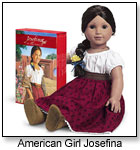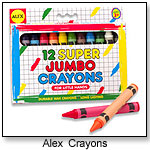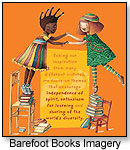 |

Tools:








Branding Toys: PersonalityCreating an Emotional Connection
| “It’s all about reaching buyers on an emotional level.” |
Continuing from last month’s article, “Branding Toys: The Position,” we now look at the third of the 4Ps of branding: personality — the human attributes, attitudes and perspectives from which your company approaches its audiences.
THE 4Ps: PERSONALITY
 Personality is the hardest aspect of branding to define, the least straightforward to employ, and yet, the most important for reaching consumers and convincing them to purchase your toy or game. It’s all about reaching buyers on an emotional level. Personality is the hardest aspect of branding to define, the least straightforward to employ, and yet, the most important for reaching consumers and convincing them to purchase your toy or game. It’s all about reaching buyers on an emotional level.
Coke and Pepsi sell similar products, as do Apple and IBM, and Barbie and American Girl [both from Mattel]. Yet each does it differently. Coke addresses the family, creating warm moments around the fire with Santa Claus. Pepsi hurls the new generation off cliffs with the comfort of a hang glider overhead. Barbie sells the fun, aspirational “it” girl. American Girl sells girls of substance, history and character.
As people differ in their personalities, so do brands. Try pairing human attributes with your brand to create an original and consistent feel. Are you competent? Genuine? Fun? Like people, brands can have multi-faceted personalities — both hip and intelligent, for example. Unlike people, successful brands lead with one personality attribute and use the others as support. Limit the attributes of your brand to two or three.
Creating a brand personality that mirrors the collective personality of your purchaser is the ideal way to make an emotional connection. Consider the demographics of your consumer: Are they boys or girls? Infants, toddlers or teens? From lower-income or trust-fund families? Though your game, doll or bath toy is likely inanimate, providing it with a relatable personality can help create a lasting emotional connection. Building marketing campaigns and visual representations around that connection results in an emotional impact that stays with the consumer.
CASE OF A STRONG PERSONALITY
 Like most of you, we have an outsider’s perspective on Alex Toys, knowing only what we see and hear in the marketplace. That communication adds up to a clear personality, and whether on the shelves or in your living room, spotting a product from Alex is easy. Alex Toys inspire children to think, imagine and create. They are teachers — not the kind in tweed skirts and spectacles, but the fun, hip art teacher that provides children with endless crayons, paint and construction paper. Like most of you, we have an outsider’s perspective on Alex Toys, knowing only what we see and hear in the marketplace. That communication adds up to a clear personality, and whether on the shelves or in your living room, spotting a product from Alex is easy. Alex Toys inspire children to think, imagine and create. They are teachers — not the kind in tweed skirts and spectacles, but the fun, hip art teacher that provides children with endless crayons, paint and construction paper.
The colors of the brand — vivid and primary; the typeface — young, bubbly and casual; the imagery — bright and illustrated; and the corresponding website and packaging all contribute to the brand’s distinct personality. While in a boutique toy store recently, I realized I could spot Alex Toys from a distance, and knew every time where the product was on the shelf. I found myself wishing that these were the toys I had when I was younger, so I bought a few. Isn’t that what you want your brand and its personality to inspire in consumers?
PERSONALITY IN ACTION
Personality in humans is wrapped in how we speak, look and carry ourselves. The same concept translates to personality in brand. Below are just a few simple ideas for creating and integrating the look, voice and feel of your brand:
 Look It. Establish a distinct look that conveys a clear personality. Select consistent imagery that will be used on all materials — from packaging to the website and catalogs to advertisements. What will the imagery that surrounds your logo inspire? What will be the brand’s overall visual representation? Create a mood board for inspiration and consider various options. Will you use modern and sleek photography? Bright and colorful illustrations? Treated images that create a proprietary feel? All can be done inexpensively with royalty-free images at a variety of stock photography houses. Look It. Establish a distinct look that conveys a clear personality. Select consistent imagery that will be used on all materials — from packaging to the website and catalogs to advertisements. What will the imagery that surrounds your logo inspire? What will be the brand’s overall visual representation? Create a mood board for inspiration and consider various options. Will you use modern and sleek photography? Bright and colorful illustrations? Treated images that create a proprietary feel? All can be done inexpensively with royalty-free images at a variety of stock photography houses.
Sound It. Words are as important as pictures. Establish a consistent language that conveys who you are — a best friend, a fun teacher, a caring parent. Embrace the personality. Talk like that person. Use words that person would use. Consistently incorporate a vocabulary and tone that is yours — and reflects the products offered — as well as the people you are selling to.
Act It. Part of the attitude component is inherent to the products themselves. For instance, Baby Einstein relates to babies and toddlers as a teacher. Decide who you want to be to children and their parents, and be certain that everything you do is positioned from that perspective. The only rule is consistency; pick an attitude or position and stick to it.
Next month, we’ll close this series with a final look at the last of the 4Ps: perception.
 Writer's Bio: Writer's Bio: As a managing partner and co-founder of Flag + Company, Beth has branded, defined, re-defined, and marketed organizations of all sizes and sectors. Prior to founding Flag, Beth served as a senior director at The Delve Group, a strategic branding firm focused on the business-to-business sector, and creative director at D2 Creative, where she established a traditional marketing and strategy division within an interactive agency. Read more about her company at www.flagandco.com. Read more articles by this author
THIS BANNER IS AN AD:

• • • • • • • • • • • • • • • • • • • | • • • • • • • • • • • • • • • • • • • |
Back to TDmonthly's front page
|  |
Advertise on TDmonthly

|

